
The L-ring of the bacterial flagellum is the ring in the lipid outer cell membrane through which the axial filament (rod, hook, and flagellum) passes. [1]

The L-ring of the bacterial flagellum is the ring in the lipid outer cell membrane through which the axial filament (rod, hook, and flagellum) passes. [1]

A flagellum is a lash-like appendage that protrudes from the cell body of certain bacteria and eukaryotic cells termed as flagellates. A flagellate can have one or several flagella. The primary function of a flagellum is that of locomotion, but it also often functions as a sensory organelle, being sensitive to chemicals and temperatures outside the cell. The similar structure in the archaea functions in the same way but is structurally different and has been termed the archaellum.

The evolution of flagella is of great interest to biologists because the three known varieties of flagella each represent a sophisticated cellular structure that requires the interaction of many different systems.
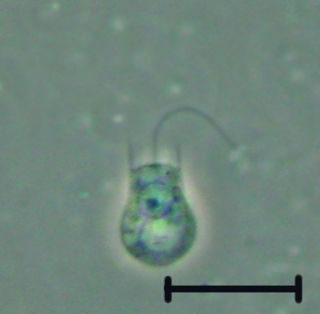
The choanoflagellates are a group of free-living unicellular and colonial flagellate eukaryotes considered to be the closest living relatives of the animals. Choanoflagellates are collared flagellates having a funnel shaped collar of interconnected microvilli at the base of a flagellum. Choanoflagellates are capable of both asexual and sexual reproduction. They have a distinctive cell morphology characterized by an ovoid or spherical cell body 3–10 µm in diameter with a single apical flagellum surrounded by a collar of 30–40 microvilli. Movement of the flagellum creates water currents that can propel free-swimming choanoflagellates through the water column and trap bacteria and detritus against the collar of microvilli, where these foodstuffs are engulfed. This feeding provides a critical link within the global carbon cycle, linking trophic levels. In addition to their critical ecological roles, choanoflagellates are of particular interest to evolutionary biologists studying the origins of multicellularity in animals. As the closest living relatives of animals, choanoflagellates serve as a useful model for reconstructions of the last unicellular ancestor of animals.
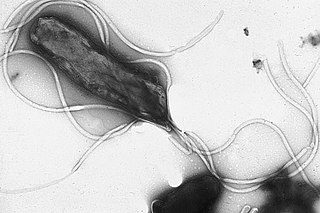
Flagellin is a globular protein that arranges itself in a hollow cylinder to form the filament in a bacterial flagellum. It has a mass of about 30,000 to 60,000 daltons. Flagellin is the principal component of bacterial flagellum, and is present in large amounts on nearly all flagellated bacteria.

Trypanosoma brucei is a species of parasitic kinetoplastid belonging to the genus Trypanosoma. The parasite is the cause of a vector-borne disease of vertebrate animals, including humans, carried by genera of tsetse fly in sub-Saharan Africa. In humans T. brucei causes African trypanosomiasis, or sleeping sickness. In animals it causes animal trypanosomiasis, also called nagana in cattle and horses. T. brucei has traditionally been grouped into three subspecies: T. b. brucei, T. b. gambiense and T. b. rhodesiense. The first is a parasite of non-human vertebrates, while the latter two are the known parasites of humans. Only rarely can the T. b. brucei infect a human.
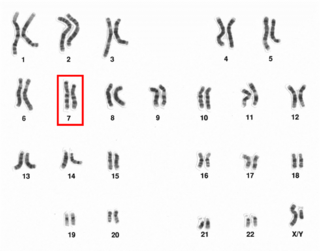
Chromosome 7 is one of the 23 pairs of chromosomes in humans. People normally have two copies of this chromosome. Chromosome 7 spans about 159 million base pairs and represents between 5 and 5.5 percent of the total DNA in cells.

Biomolecular structure is the intricate folded, three-dimensional shape that is formed by a molecule of protein, DNA, or RNA, and that is important to its function. The structure of these molecules may be considered at any of several length scales ranging from the level of individual atoms to the relationships among entire protein subunits. This useful distinction among scales is often expressed as a decomposition of molecular structure into four levels: primary, secondary, tertiary, and quaternary. The scaffold for this multiscale organization of the molecule arises at the secondary level, where the fundamental structural elements are the molecule's various hydrogen bonds. This leads to several recognizable domains of protein structure and nucleic acid structure, including such secondary-structure features as alpha helixes and beta sheets for proteins, and hairpin loops, bulges, and internal loops for nucleic acids. The terms primary, secondary, tertiary, and quaternary structure were introduced by Kaj Ulrik Linderstrøm-Lang in his 1951 Lane Medical Lectures at Stanford University.

In molecular biology, LSm proteins are a family of RNA-binding proteins found in virtually every cellular organism. LSm is a contraction of 'like Sm', because the first identified members of the LSm protein family were the Sm proteins. LSm proteins are defined by a characteristic three-dimensional structure and their assembly into rings of six or seven individual LSm protein molecules, and play a large number of various roles in mRNA processing and regulation.

Probable G-protein coupled receptor 171 is a protein that in humans is encoded by the GPR171 gene.

60S ribosomal protein L7a is a protein that in humans is encoded by the RPL7A gene.

60S ribosomal protein L19 is a protein that in humans is encoded by the RPL19 gene.

Zinc finger protein 655 is a protein that in humans is encoded by the ZNF655 gene.

Zinc finger protein 451 is a protein that in humans is encoded by the ZNF451 gene.

28S ribosomal protein S22, mitochondrial is a protein that in humans is encoded by the MRPS22 gene.

A-kinase anchor protein 4 is a scaffold protein that in humans is encoded by the AKAP4 gene. It involves in the intracellular signalling of protein kinase -A. AKAP4 is called as cancer /testis antigen (CTA), it belongs to a class of tumour linked antigens categories by high expression in germ cells and cancer than normal tissues. AKAP4 is not normally expressed in mRNA and protein level in MM cell line.

RING finger protein 37 is a protein that in humans is encoded by the UBOX5 gene.

39S ribosomal protein L24, mitochondrial is a protein that in humans is encoded by the MRPL24 gene.

CatSper2, is a protein which in humans is encoded by the CATSPER2 gene. CatSper2 is a member of the cation channels of sperm family of protein. The four proteins in this family together form a Ca2+-permeant ion channel specific essential for the correct function of sperm cells.
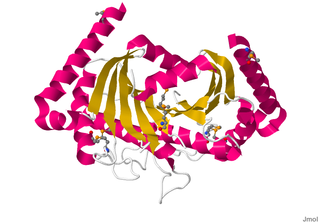
Motility protein B also known as MotB is a bacterial protein that is encoded by the motB gene. It's a component of the flagellar motor. More specifically, MotA and MotB makes the stator of a flagellum and surround the rotor as a ring of about 8-10 particles. MotA and MotB are integral membrane proteins. While both MotA and MotB surround the MS ring, MotB also anchors MotA to cell wall peptidoglycan. These two proteins form pores that harvest energy for flagellar mechanical movement by proton motive force (PMF) across the membrane. Cellular metabolic processes such as the electron transport chain move protons outside the cell, creating more protons and more positive charge in the extracellular space. When the protons flow back into the cell through MotA and MotB along concentration and charge gradients, they release energy that is used for flagellar rotation. The speed of the flagellar motor is dependent on the magnitude of the PMF acting on MotA and MotB.
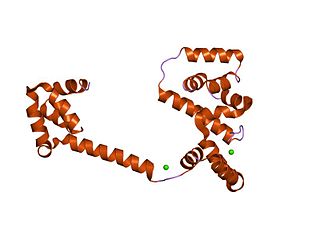
In molecular biology, the flagellar motor switch is a protein complex. In Escherichia coli and Salmonella typhimurium it regulates the direction of flagellar rotation and hence controls swimming behaviour. The switch is a complex apparatus that responds to signals transduced by the chemotaxis sensory signalling system during chemotactic behaviour. CheY, the chemotaxis response regulator, is believed to act directly on the switch to induce tumbles in the swimming pattern, but no physical interactions of CheY and switch proteins have yet been demonstrated.
| This bacteria-related article is a stub. You can help Wikipedia by expanding it. |